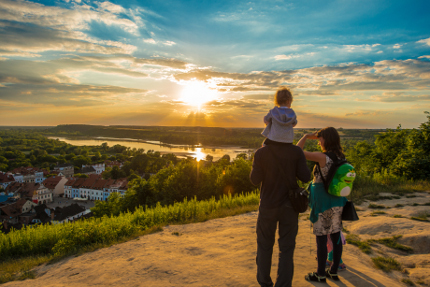Kazimierz Dolny is a favorite place of the painters, photographers, and filmmakers. It owes its fame to the great harmony of the landscape, combining the nature of the Lesser Poland Gorge of the Vistula River with wonderful architecture. The castle and a stone tower, that once guarded the Vistula crossing, come from the period of the foundation of the city by Casimir the Great. The greatest development of trade took place in the 16th and 17th centuries. During this period, the city was expanded in the Renaissance style, the Parish church and the church of St. Anne were erected, as well as the tenement houses of the Przybyła and Celej families, and numerous granaries. By the Vistula river there is a port and a walking boulevard. The Kazimierz Landscape Park surrounds the town. It is a perfect place for walking the paths leading through loess gorges and high slopes with viewpoints over the panorama of the Vistula river.
The parish church of St. John the Baptist and St. Bartholomew. The gothic church destroyed during the fire was rebuilt between 1610 and 1613 by Jakub Balin - a Lublin architect of Italian origin. A slender, single-nave temple with a lower semi-circularly closed presbytery and two characteristic gables connecting the influences of Italian and Dutch architecture was created. The barrel vault of the nave and presbytery are decorated with magnificent stucco decorations. In the 17th century, the chapels of Borkowski and Górski families, together with the Rosary chapel, were added to the parish church. Inside the temple, in the music choir, there are 17th-century organs considered to be the oldest, fully preserved, musical instrument of this type in Poland. Among many interesting elements of the church's equipment, rococo confessionals and a stone baptismal font made in the workshop of Santi Gucci are especially noteworthy. The main altar contains paintings from the 19th century depicting Saint Bartholomew and Kazimierz Jagiellończyk.
St. Anne's church. Following the example of the Kazimierz parish church, a brick one-nave church was built with a narrower semi-circularly closed presbytery. Renaissance gables decorated with pilasters were crowned with pyramids. The vault of the nave and the presbytery are covered with a simple stucco pattern. In the 18th century main altar there is a picture of St. Anne accompanied by Jesus and the Mother of God. Wooden side altars come from the 17th century. The Renaissance polychrome on the rainbow arch draws the attention. The building next to the church once served as a hospital and asylum for the poor and the elderly.
The granaries. In the heyday of Kazimierz Dolny, next to church foundations and the construction of numerous tenement houses in the market square, the granaries were erected along the Vistula river to store grain. In total, about 60 objects of this type were created. The most magnificent of them were located at today's Puławska and Krakowska Streets. Only a few have survived to this day. The slender, triangular, tops of the granaries topped with pyramids were modeled on the Kazimierz parish church, thus introducing elements of the Lublin Renaissance to secular architecture. The Feuerstein's Granary, which used to be a tannery, also refers to the Renaissance forms of the parish church. From the 19th century, granaries falling into ruin began to be adapted for other purposes. After subsequent renovations carried out in the 20th century, including the one according to the design of Karol Siciński, the Granary of Kobiałki was designated to serve as a tourist hostel, while in the Granary of Ulanowski (Przybyła) a Natural Museum was created - a branch of the Nadwiślańskie Museum.
Events:
National Festival of Folk Bands and Singers in Kazimierz Dolny (June)
Kazimiernikejszyn (July)
Two Riversides Film and Art Festival (July)





